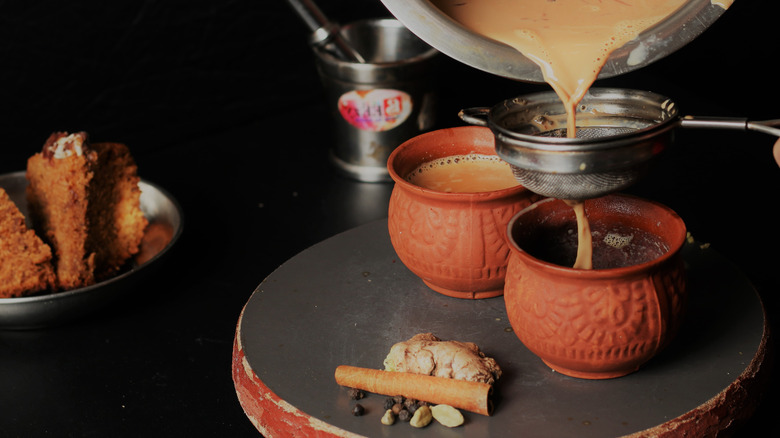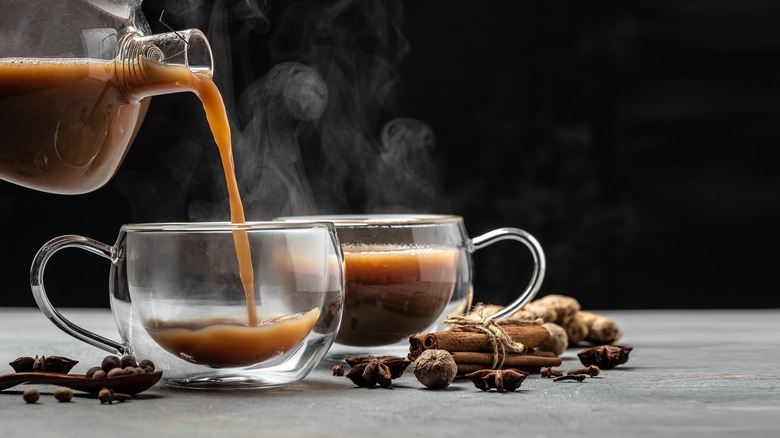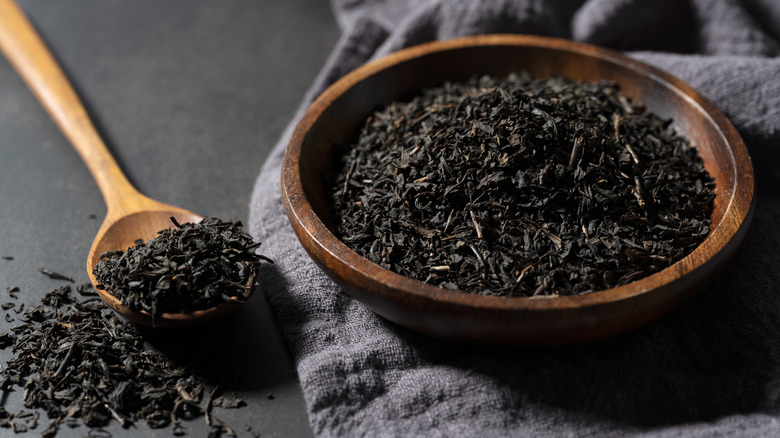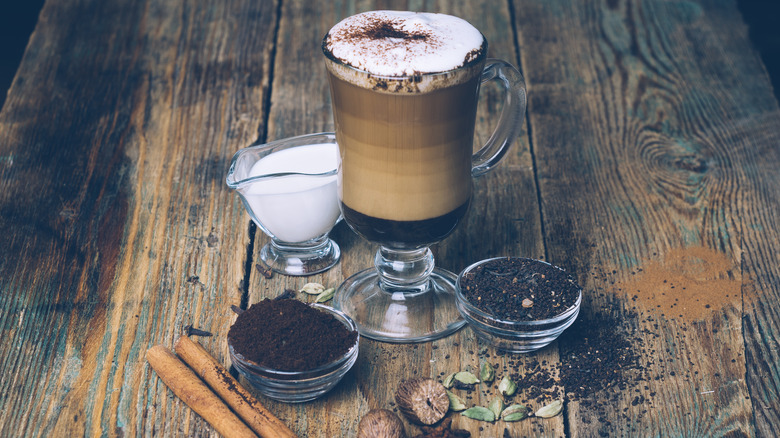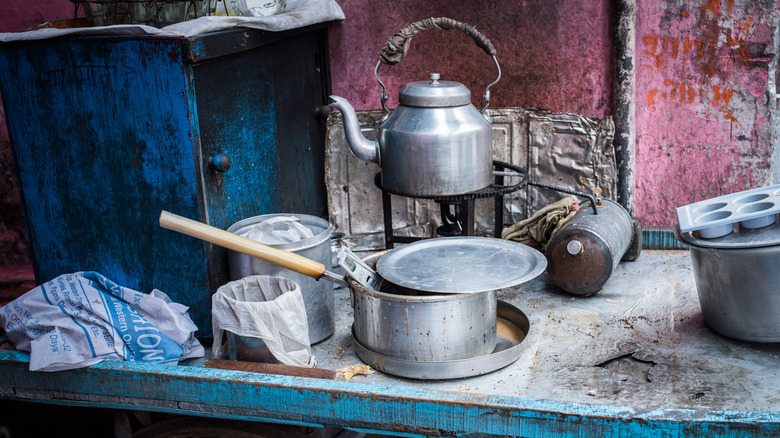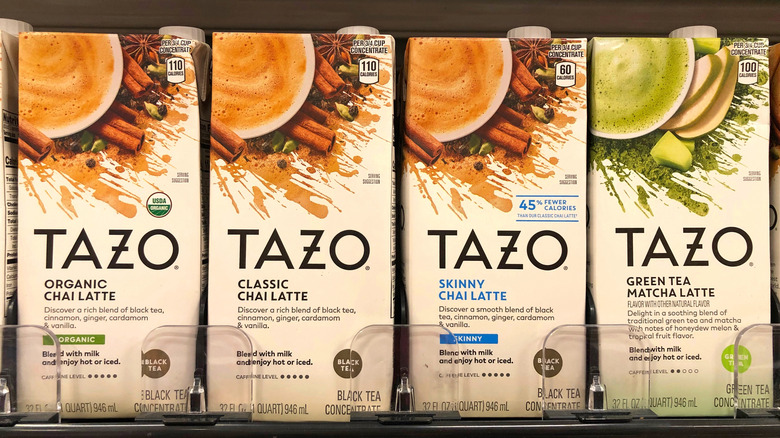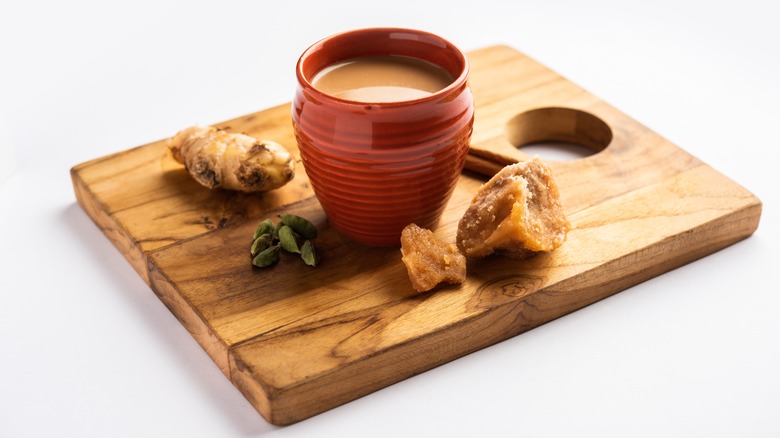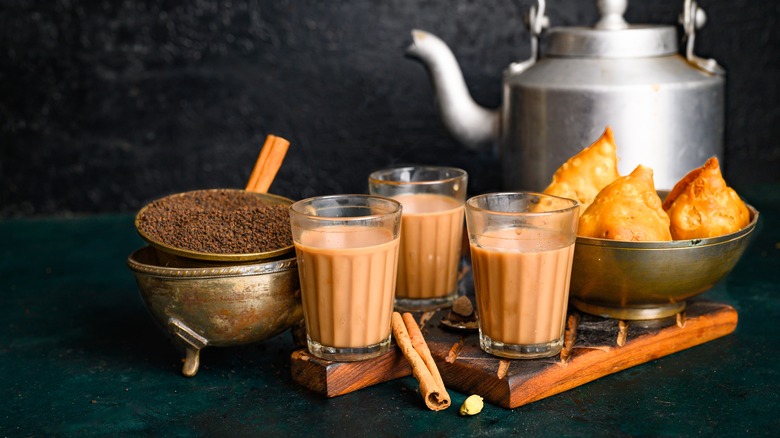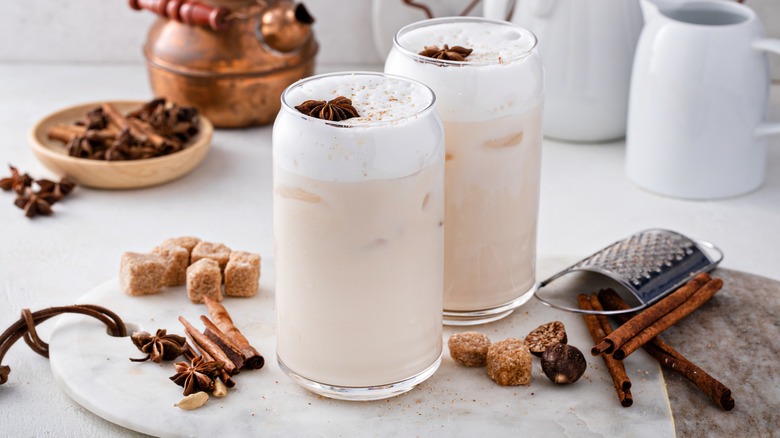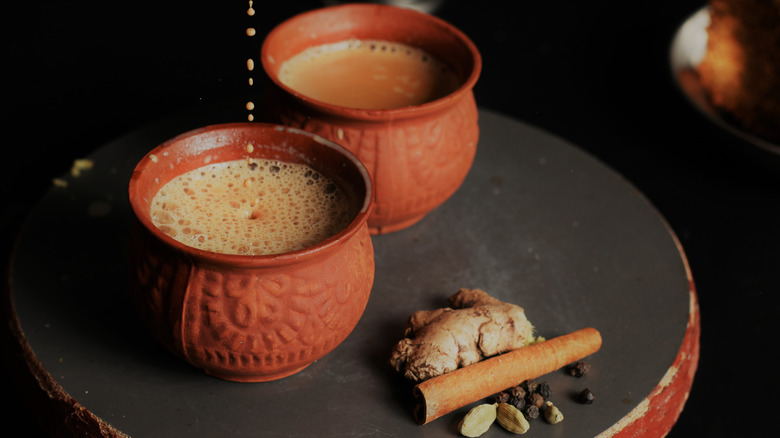19 Facts You Need To Know About Chai
Chai was created 5,000 years ago in modern-day India, and it's been a tradition in the country ever since. It's such an integral part of people's day that Members of Parliament in Assam have urged the central government to make chai India's national drink. It's a perfectly warming way to start the day, from the temperature of the milk-infused tea to the spices used to make the tea unique.
If you've only had chai in the West, you might be surprised to learn that these versions don't necessarily represent true Indian chai. American chai lattes are vastly different from the ones found on the streets of India, from the name we give them to the flavor profile. Of course, this isn't necessarily a negative; chai flavor profiles vary from household to household in India, and they can contain different ingredients as you move across the region. If you're ready to learn more (and stop calling it by the wrong name), this is everything you need to know about chai.
You shouldn't call it chai tea
Chai has been around for thousands of years, but it's only in the last few decades that it earned its redundant name. The drink is well-known in the East, but it wasn't introduced to the West until the mid-1990s, when Oregon Chai introduced their take on this spiced tea to the United States. Around the same time, Starbucks announced a latte featuring the iconic drink. Both called their product chai tea latte.
That's all well and good, but TikTok's 'CEO of Chai' wishes you'd stop saying that, along with probably anyone who speaks Hindi. You see, "chai" is the Hindi word for "tea," so putting the two words together is like calling it a "tea tea" latte. It's saying queso cheese dip (cheese cheese dip). So, the next time you want to order this drink, simply call it "chai" and be done with it.
Chai was original made without tea leaves
You might be surprised that although the word "chai" means "tea," the drink didn't originally contain tea leaves. Chai initially referred to an infusion of herbs and spices like cinnamon, cardamom, ginger, and black pepper. The original purpose of chai was for holistic healing, and the drink was used by Ayurvedic practitioners.
When the British colonized India in the 19th century, they established tea plantations in Assam, a state in northeastern India. Slowly but surely, black tea began to be incorporated into chai recipes, along with the milk and sugar that were typical in a British cup of tea. After India gained its independence, the drink had become so ingrained in the country's culture that most adults start their day with a cup. Today, Indians have embraced this sweetened, spiced tea and tout it as India's national drink.
Chai isn't as sweet as chai lattes
While most traditional chais do contain some sweetener, they're nowhere near as cloying as the ones you'll find at a coffee shop. Starbucks Grande Chai Tea Latte, for example, contains 240 calories and 42 grams of sugar. Considering that one sugar packet or teaspoon of sugar weighs about 4 grams, that's more than 10 teaspoons of sugar in a 16-ounce beverage. Can you imagine actually scooping that much sweetener into your morning tea?
Of course, when you make it at home, you're able to control the amount of sugar it contains. Traditional recipes often use honey, although it's important to let the tea cool first, as honey can become toxic when heated. Although it's not customary, you can make it with alternative sweeteners like maple syrup, agave syrup, or stevia.
The spices help your body digest the dairy
According to Amita Nathwani, Ayurvedic practitioner and author of "My Mother's Ayurvedic Kitchen," the spices in chai were once used as an Ayurvedic remedy. Ayurveda is a 5,000-year-old science, and it's one of the world's earliest healthcare systems. Ayurvedic practitioners combine herbs and spices to promote holistic healing, and chai is one of those remedies.
Nathwani tells us that the spices in chai are designed to create heat that helps the body break down the saturated fats in dairy as it's digested. Dairy is full of saturated fats, which Ayurveda says are essential to the body, but the body can sometimes use a little assistance to break them down. A typical chai recipe might include heating spices like cardamom, cloves, cinnamon, ginger, and ground black pepper. She notes that in the winter, the digestion is not as strong, so grated ginger is added to further stimulate the digestion.
Chai has many health benefits
Chai doesn't only contain health value in Ayurvedic medicine, as studies show many health benefits associated with drinking the spiced tea. Some of the benefits come from the black tea itself. According to a study in Clinical Nutrition, that tea consumption lowers LDL cholesterol (the "bad" cholesterol), especially in those with higher cardiovascular risk, and in a separate study it has been shown to reduce coronary heart disease and improve mental performance.
The spices also play a role in human health. In addition to being an antioxidant, a study in Evidence-Based Complement Alternative Medicine has shown that cinnamon contains anti-inflammatory and lipid-lowering properties, and it may be effective as a therapeutic intervention for neurological disorders like Parkinson's and Alzheimer's. The cardamom used in chai has also been known for stimulating metabolism and improving digestion, per the British Journal of Nutrition, and ginger may be helpful in preventing colon cancer because of the way it accumulates in the gastrointestinal tract, according to "Herbal Medicine: Biomolecular and Clinical Aspects." It can also be helpful in reducing the risk of diabetes and cardiovascular disease.
You can amp up the caffeine content by making a dirty chai
If you're looking to reduce your daily caffeine intake, switching from coffee to chai may be the way to go. An eight-ounce cup of coffee contains nearly 100 milligrams of caffeine, whereas the same quantity of brewed black tea contains just shy of 50 milligrams. Green tea has even less, clocking in at almost 30 milligrams.
It's possible to have the best of both worlds, increasing the caffeine level of chai by adding a shot of espresso. A dirty chai latte is believed to be an accidental coffee shop invention, when a barista accidentally poured a shot of espresso into a customer's chai latte. Considering that espresso has roughly 64 milligrams of caffeine, that extra shot will take your black tea to a similar caffeination level as coffee.
Tea vendors line the streets of India
It may be commonplace to make chai at home in India, but that doesn't mean there aren't ample ways to get this tasty treat on the go. Where the West has coffee shops, India has chai wallahs. Wallah is a word that follows one's profession, so a rickshaw wallah would be one who drives a rickshaw and a chai wallah is one who makes and sells chai. It's a big business in India, and Prime Minister Narendra Modi got his start as a chai wallah.
You can find these tea vendors on virtually every street corner in India. The traditional ones may prepare your tea over a clay stove or another wood-fired apparatus, but it's more typical to find gas-powered stoves today. Each chai wallah brews their tea slightly differently, and they all claim to have the best tea in the state. You'll only know who's telling the truth if you try them all.
Many coffee shops use chai concentrate instead of brewing it fresh
Where India's chai wallahs make their chai fresh to order, the West's coffee shops prefer using chai concentrate. That's not to say that some don't make their own concentrate, and we're sure that many coffee shops take on a traditional model and make the tea with whole spices instead. However, chai concentrate because it's an easy shortcut to reduce the time it takes to make a chai latte.
Chai concentrate is a very strong black tea that's similar to fresh-brewed chai, but it's way too strong to drink on its own. Instead, it's diluted with water or milk. Depending on how strong you like your tea, you can use equal parts concentrate and water or milk or adjust the ratio according to your tastes. Store-bought chai concentrates like Oregon Chai or Tazo Chai tend to be very sweet. If you make your own concentrate at home, you can control how much sugar goes into the mixture.
Chai spice is commonly added to pastries
The spices added to chai vary from household to household, but a typical mixture includes cardamom, cinnamon, black pepper, cloves, and ginger. This collection of warming spices is fairly similar to pumpkin spice or gingerbread spice. While there is no single recipe for these spice blends, they're perfect for baking because they contain a variety of warming spices like cinnamon, nutmeg, clove, allspice, and ginger.
When you look at these spice blends side-by-side, it's no wonder that more people have started cooking with chai. You'll find chai-spiced pastries like cinnamon rolls and muffins, and the spice blend is a perfect match for poached fruit like apples or pears. The next time you're serving a dessert with vanilla ice cream, try sprinkling on a little chai spice and watch with wonder how the addition of cardamom and black pepper opens up the flavor profile. Chai spice isn't just for desserts, either. Try adding it to rice to add a depth of richness, or use it to season meats like chicken or lamb before tossing them on the grill.
Think twice before making chai with alternative milk
Many chai recipes contain as much milk as water, so it's kind of an important ingredient! Almost every coffee shop you go to today provides a host of dairy-free milk alternatives, from soy and almond milk to hemp, coconut, or oat milk. While you can use these alternatives in your morning cup of chai, you should think twice before doing it.
WebMD's chai latte recipe caused a lot of controversy when they tweeted out a recipe that included star anise, maple syrup, and used coconut milk instead of a dairy-based milk. Twitter's Indian community responded with dismay, calling it cultural appropriation.
As Nathwani explained to us, the West is rich with milk substitutes, but these substitutes are not the avenue through which Ayurveda is practiced. In Ayurveda, milk is a nourishing substance, providing the necessary saturated fat the body needs for proper functioning. This is why many Indians choose to start their day with warm milk.
You don't want to oversteep chai
Whether you're making chai fresh in the morning or preparing a batch of chai concentrate to use throughout the week, there's one thing you definitely want to avoid: oversteeping the tea. Dunking a tea bag while steeping tea helps the water come into contact with the leaves inside, infusing the water with the tea's essential compounds. One of these compounds is tannins, an astringent agent that can become bitter-tasting when you steep your tea too long.
This is where you want to pay attention to the order in which you add your chai ingredients. Nathwani says everyone makes their chai a little bit differently, but you can avoid the bitter flavor by making a less strong chai. Instead of adding the tea at the same time as the spices, try simmering the spices before you add the tea bag. This will allow you to benefit from chai's warming flavors without making it too strong (and too bitter).
When you add the milk matters
To make chai, some steep the tea and spices in the milk straight away as the milk and water are boiling. Others prefer to do so in water, adding the milk after. Although it's a matter of personal preference, the way you add the milk does matter in the end.
Your chai will change in density and in flavor depending on when you add the milk. Adding it along with the spices and tea will cause some of the milk's water content to evaporate, concentrating its sweetness and resulting in a thicker texture. The chai will also be bolder in spice, as the flavor compounds in the spices are fat-soluble and diffuse better in fat-rich milk. Conversely, if you boil the spices and tea in the water first and add the milk after, the tea's flavor will not be as bold, and the tea will be thinner.
There are multiple chai variations
The chai we know from our local coffee shop has a pretty familiar flavor profile that doesn't change from shop to shop. However, in India and across the East, there are other versions of chai that use different types of tea and different spice profiles to give it a regional twist.
Some versions vary in the spice content or the strength of the tea. For example, masala tea is likely more heavily spiced than the one you'll get at your local coffee shop, and karak chai is even stronger, either containing extra tea or boiling the tea longer to make the cup bolder than the typical chai. Then there are chais that include different types of milk, like Irani chai's addition of mawa or khoya, a type of sweetened condensed milk that makes the tea extra sweet and creamy.
Kashmiri chai is pink
One of the most famous regional varieties of chai is Kashmiri chai, also called noon tea or noon chai. The first striking difference between chai and Kashmiri chai is the color: it's a striking pink color that is impossible to miss. Tea makers add baking soda to the mix, which sounds strangem but it undergoes a chemical reaction when it mixes with the chlorophyll in the tea leaves.
This chai is also brewed with a specific tea instead of green tea. Kashmiri tea is similar to green tea, and it lightens the tea's original color to make the pink that much more vibrant. Most Kashmiri chai is garnished with crushed nuts, like almonds or pistachios.
Chai is often served with snacks
Chai can certainly be enjoyed on its own, but it's even better when it's served with snacks. The type of snack depends on when the chai is served. Parley-G biscuits are wildly popular in India, and you can find them in almost every household. These sweet, malty biscuits pair perfectly with chai in the morning as a light accompaniment to tea. Rusk is another type of biscuit that you'll find paired with chai for breakfast.
If you're looking for a heartier option, look to ajwain paratha, a flatbread made with carom seeds. You can never go wrong with samosas, either — deep-fried pastries stuffed with a spiced filling. When you're feeling more like snacking than eating, reach for Bikaneri bhujia, a savory, crunchy mixture with a noodle-like texture.
India is the second largest producer of tea in the world
It's no surprise that a country that loves tea would be one of the largest producers of tea in the world. India is the second largest producer of tea in the world after China. China may produce over 2 million tons of tea per year, but over half of India's 1.2 million tons of tea stays in the country to be consumed by its residents.
You might recognize the varieties of tea grown in India: Assam (a popular choice for chai) and Darjeeling. You can use either when making chai at home, but each will impart a slightly different profile. Assam is darker and stronger whereas Darjeeling has a fruitier and spicier profile.
Ordering a half cup is known as cutting chai
If you're in Mumbai and you want to try chai without committing to a whole glass, ask the chai wallah to cut the chai. Cutting chai refers to reducing the portion (and the price) in half. It's a perfect way to enjoy tea with a more filling snack or reduce the amount of caffeine you consume in a day.
Sudhir Malhotra, owner of Café Chai Bar, told NDTV Food that the concept of serving a half glass of chai arose to allow people to cut back on the amount of chai they drink in a day. Malhotra explained that most people can drink two or three cups of chai per day, so reducing the serving to a half cup made sense to enjoy the custom of drinking tea without consuming as much.
Iced chai isn't recommended — even in the summer
Iced chai is popular in the West, especially when it's hot outside, but you probably won't find it in India. According to Nathwani, the Ayurvedic solution to cooling down in the summer would be to add mint leaves to your tea (a cooling spice). Drinking ice-cold beverages can slow down digestion, and it may even cause issues with the liver. A study in the journal Traditional and Integrative Medicine analyzing the effect of ice-cold water in rats also indicated that long-term exposure to cold beverages had harmful effects on the liver.
So, although it sounds ridiculous to drink a piping-hot drink on a hot day, you should probably ask for your chai hot instead of serving it over ice. According to a study in Acta Phyisologica, these hot drinks might actually be able to keep you cooler on a hot day anyway because it triggers the body's response to sweat.
The authentic way to serve chai is in a clay cup
If you order chai in India, it might be served in a clay cup called a kulhad. In fact, you don't have to be in India to experience this traditional way of drinking chai, as the cups are available from online retailers.
The hot tea soaks into the unglazed clay to infuse the chai with an earthen flavor and aroma that you'll miss when you drink out of glass or ceramic mugs. Traditionally, when you're finished drinking, you would throw the cup on the floor. The practice began as a separatist movement to ensure that members of different castes wouldn't drink from the same container. However, today it's done as a more symbolic to return the clay back to the earth from which it came.
